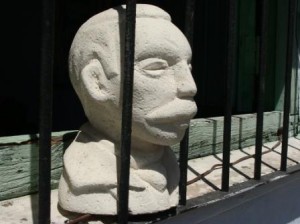Cuba’s Marti Is Everywhere and Nowhere
By Amrit

HAVANA TIMES, Jan 21 — As I mentioned in a previous post, my mother told me that she had invited my 21-year-old niece to go see Fernando Perez’s film “Marti and the Eye of the Canary”. When this young woman replied, “I’m not watching that shit,” I was stunned.
But then I realized that this same reaction — a mixture of disgust and despair — was echoed among many teens and younger people when they talked about that film.
Yet are they to blame? How can anyone not feel overwhelmed by a plaster hero that’s seen not only in schools and government offices, but also in parks, outside of apartment buildings and even in front of the neighborhood bakery!?
Overlooking any school or office one finds these busts of Marti, deformed due to the incompetence of artists who reproduce them “ordered in advance.” There sits this hero who drums into our heads a silent speech that doesn’t interest us.
“I lived in the monster and I know its entrails,” we hear, we read – but what monster? What society on this planet is free of selfishness and injustice disguised in this or that form of political sophistry?
“To be cultured and educated is to be free…” With the younger generation deformed by teachers who are practically their same age and possess even worse manners, where’s the culture, where’s the freedom? Where is that other form of intelligence that doesn’t require intellectual wealth and that includes sensitivity?
From plaster pedestals, these almost inhuman Marti’s look impassively at our weaknesses and anguish. Each is like one of those stuffed animals with which the taxidermist tries to capture the soul, though it’s absent from those fixed pupils. Its soul flew away, leaving us only an empty shell.

Still, when I saw the movie Marti and the Eye of the Canary, I was rocked by an unexpected jolt. It made me turn to Wikipedia the next day to try to re-discover the humanity of this person who not without reason has been called “the greatest of all Cubans,” but who isn’t in the history books – despite how much he’s mentioned in them.
I understood why for years my son has preferred Wikipedia to his textbooks as a reference for his schoolwork.
I believe that as victims of the mediazation in this “civilized” world, we all have passed into a state of profound atrophy. But our saturation with eminence — that eminence that pushes us to the point of shuddering, like what cod liver oil does to a child who refuses it with grimacing and gagging — is one of the most egregious.
This is because it destroys the very thing that can save us. In the confusion of this frantic race that we call “life,” it eliminates that which can bring some light, some relief…
Only a few years ago I learned that Marti said things I would have liked to have read when I was in elementary school:

“When people are born
they stand by their bed
with strong bandages prepared in their hands,
with all of the philosophies,
religions
and political systems.
And they tie and band them on.
And then the person is already
for their life on earth
a bridled horse (…)
I am a horse without a saddle.
From no one do I receive the law,
and nor do I try to impose it on anyone…”
I heard this from a rapper who joined thoughts by Marti in his lines. I was taken aback by this this new and unknown Marti, this Marti who was as wise as those spiritual masters who satisfy our hunger for the truth in a few simple passages!
I look at the gypsum Marti’s (these days also made of plastic), so alien and immutable that they seem never to have thought anything as profound.
Could that be why my 21-year-old niece, though she refused to watch the film by Fernando Perez, told me confidentially — with more astonishment than malice — “They say that Marti is shown masturbating.”
Yes, a trait of humanity escapes from the stone, though it’s usually absent. I hope that such details are enough to tempt many youth and teens to discover this person, this huge person who doesn’t sit on a pedestal.
Let’s hope that other films or pretexts will emerge to help us not to be resign ourselves to these plaster heroes, but to seek the truth – that which they hide from us.
Perhaps we will find those who were as imperfect as we are but who fought for a more just world, which is only possible with the acceptance of our humanity, and not with the sacrifice of it.





